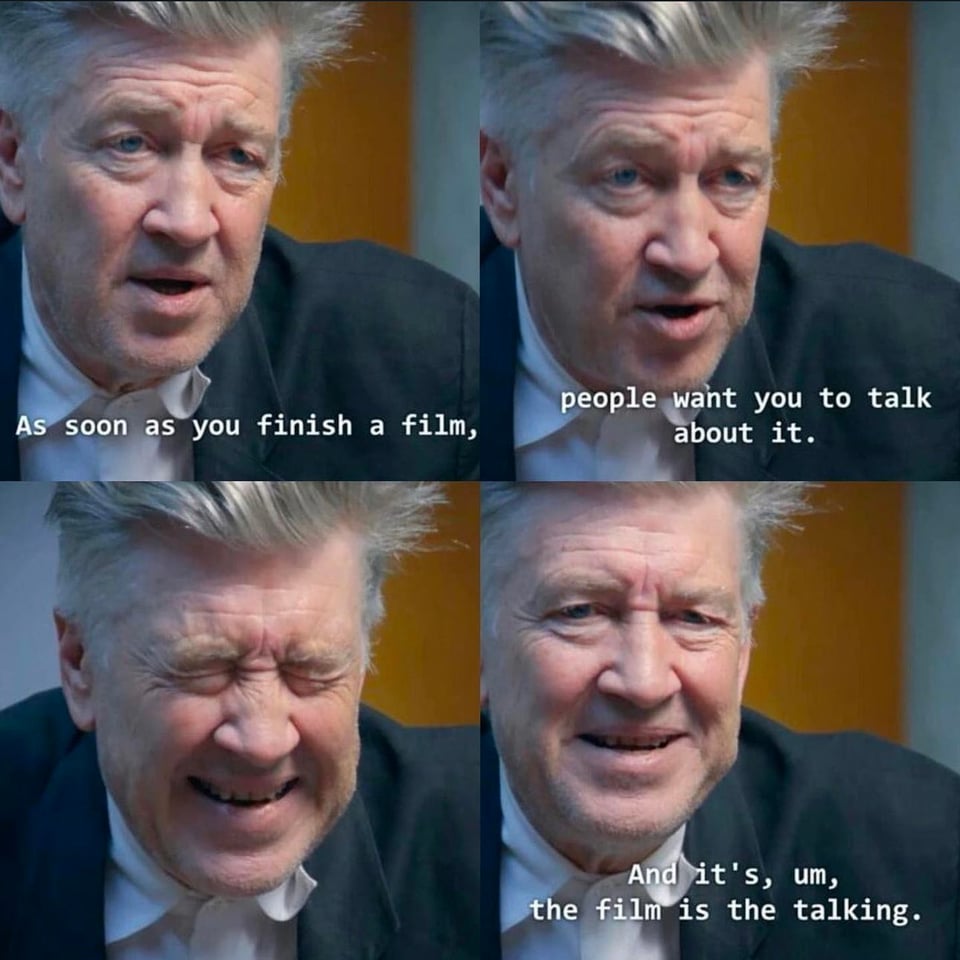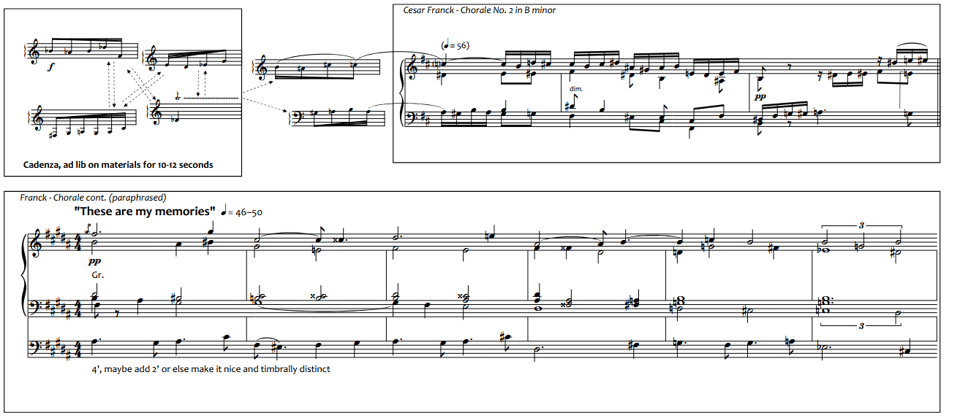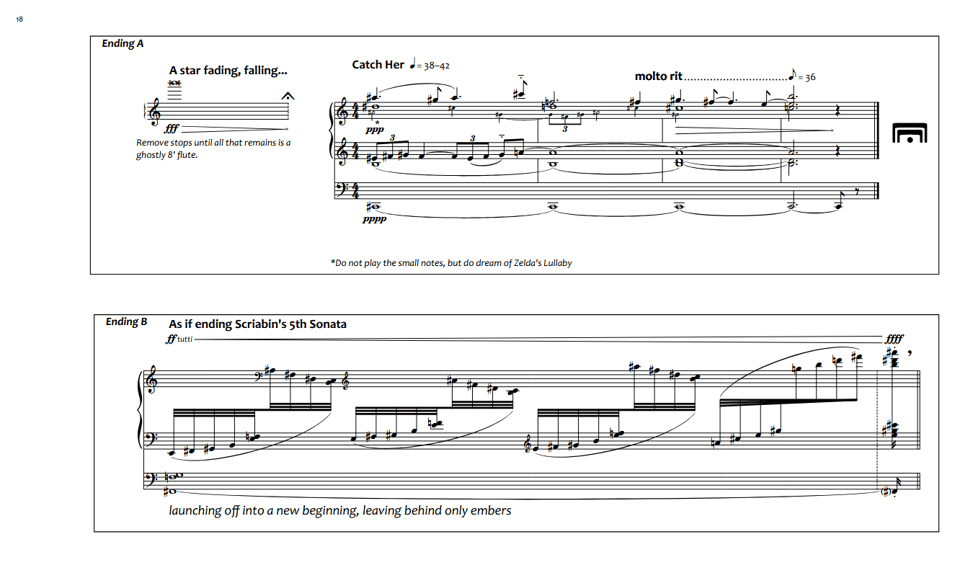Conversation on/in (my) art (copy)

I hate program notes. I can tolerate program notes as written by the performer, or program notes written by a listener, but program notes that come from the artist themselves, those I cannot stand. The attempt to reduce a piece of music — that I deliberately wrote without words — to some narrative, some pretty picture that easily sums up something I put (on average) 3-6 months of my life into, it’s miserable. These are such a commonly desired piece of the contract between composer, performer, and listener, and they are without fail the most miserable part of creation for me.
Maybe I’m too much of a hippie, but to pigeonhole a creative work to a set meaning is always such a visceral no-no to me. Why did I quote Alfred Schnittke’s Agony in my piece A Most Perfect Blue? Why did I do that? Let’s sit and think a while. Why does the score (but not the music) include a quote from NieR:Automata? Well worth considering. It is interesting, and exciting to engage with a work of art to your fullest faculties. Toddlers learning the rules of the world have it right, “Why” is the most exciting thing you can ask about a work of art. My goal as a composer is to give you as much access to the document as possible, which is why the pages of A Most Perfect Blue and the myriad quotations contained therein were scattered around the sanctuary the piece was premiered in.
To prescribe meaning, to bias the listener, is frustrating to me. As a result, my program notes are often frustratingly vague themselves, which is a flaw in of itself. If the audience has been coded to seek guidance in the form of program notes and has now been denied that, will they be able to approach the work in the unbiased, reactive way I would hope for?
Anyways, let’s talk a little bit about A Most Perfect Blue, not so much the piece itself, but why I felt the need to center so much of the work around quotation, why the piece itself is laid out in the way that it is.
Why so many quotes?
For a lot of my early compositional career, I was obsessed with attempting to capture the “vibes” of composers and pieces that I adored. You can hear this in say, Starting Positions, a piece I’d best describe as me desperately coping with the fact that I am neither Eric Wubbels nor Iannis Xenakis, but damned if I’m not trying to be. This is in my opinion a fun little piece, fun to play and to listen to, and it gets out of the way quickly. Yet, it’s reflective of the exact creative impulse we all struggle with: To have an original voice, yet still attempting to capture the feeling of the art that made us want to create in the first place.
Starting Positions does not exist without a healthy dose of Wubbels, Xenakis, or Twin Peaks: The Return. No art anyone has made exists without the spiderweb of all other art that has ever entered their lives, and that fact is so truly beautiful. Overt nods can feel perhaps too “winking,” but there is something striking about realizing the place a work inhabits in that web.
It may seem strange to list major influences that define A Most Perfect Blue given my reticence to color interpretation, but these are all evident on the surface provided you are familiar with the literature (and if you are not, there are citations in the score for reference and further pursuit). They are, in no particular order:
The filmographies of David Lynch and Satoshi Kon.
The French Organ School (a lineage including Cesar Franck, Louis Vierne, Jeanne Demessieux, and Olivier Messiaen).
J.S. Bach and his musical signature.
J/ARPGS (including Final Fantasy VI, The Legend of Zelda, Dark Souls, NieR(s) Replicant and Automata, and Drakengard).
House Of Leaves1 and George Crumb scores.
Michael Abels’ Urban Legends, specifically its appearance in NOPE.
The music of Aram Khachaturian, Alfred Schnittke, and just a touch of Iannis Xenakis.
Kaikhosru Shapurji Sorabji’s brilliant (and too long) Organ Symphony No. 1
The concept of intertextuality writ large.

Here, amidst a lot of personal turmoil that I won’t go into driving the music, was an attempt to create a massive symphonic work for one of my dearest friends, and creating a tableau for her and myself of the works that meant the most to us. From around 2019-2022, it was rare that my pieces would go by without at least one subtle allusion to existing material, but this was an attempt to make these quotations structural, vital to the music’s very DNA. This was art that was important to me, and I hoped that in allowing it to take up so much of the piece, I could invite the audience to appreciate the works of the past as well.
It’s very hard to say how successful this was. While people have broadly loved the piece (no less than 6 people have informed me unprompted that it made them cry), it’s been difficult to gauge the reaction to these intertextual elements. Are they recognized? Are they dismissed as gauche? How do people feel about them? I hate the thought of interrogating people, but in attempting to give myself and so many things I have loved to the audience, I cannot help but wonder: Did I succeed in giving them a glimpse of that spiderweb I see?
Here I have now turned the audience into the object to be observed (or at the very least, I want that to happen). What meaning do they find in the piece? As a whole, the audience is as reticent to share its overall reactions as I am to share the broader stories at the heart of the piece. I lack the commercial bandwith to provoke the sort of widespread interpretation and reaction that I dream of, but maybe one day I’ll reach that goal.
Of course, now that I’ve put it out there that I want to see more audience interpretation and reaction, I’ve gone and spoiled the whole thing. But it was a nice thought anyways.
So much of AMPB is my music, but my music would not be what it is without the artists and art I’ve listed. The music could not been made were it not for my year living with Autumn, where she taught me so much about the organ as an instrument and canvas, where we learned about each other as people and showed each other art that changed us forever. The music may have been made, but never could have been realized without someone who understood in the way that she did. I hope that one day the piece finds a place in the repertoire of modern organists, but they will make of AMPB a different work of art than she did. And that is beautiful.
Art cannot live on its own.
A trite truism, but true regardless =)
I make the art on the shoulders of those who have made it before me. You make the art in your performance of it, in your listening and your reaction. The meaning comes from each of us. The act of creation is vital. The act of interpretation is almost more so. I sometimes frustrate performers who aren’t as involved in the creative process with my “what do you think?” attitude when it comes to interpretation, but to see how someone sculpts my art further is all of the joy of it for me! My scores may be detailed, but I hate to prescribe the parameters beyond that.
What does it mean to you?
What did it mean to you?
What will you take from it?2
Talking about the art prescriptively is almost unavoidable in this day and age. It is a nigh compulsive choice to eliminate the act of interpretation, and it makes me sad every time I have to start placing boundaries around a piece after it’s written. Is there a story behind every piece I’ve written, a dramatic arc that helps to define and shape every score I’ve ever made? Of course there is!
But your story is so much more interesting to me.

Unrelated postscript:
Howdy! Several folk have subscribed since I started making the blog this afternoon so, thank you. Hope this was a good read! Have a great day!
Note: I had not actually read House of Leaves at the time of composing AMPB, however I was familiar with the book’s cultural reputation and its complex (inter)textual layout and was deeply fascinated by it. As such, it would be rude to not include it as an influence, however subtle. ↩
Can you tell that I was very excited to be teaching a music appreciation course before it got cancelled due to low enrollment 14 hours before I was due to start teaching? Not at all mad =) ↩
